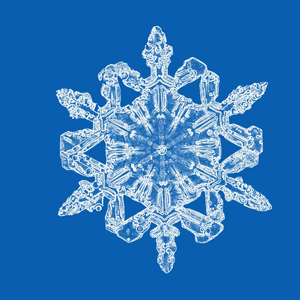The slideshow below features artistic renderings of snowflakes based on photographs that were taken by Wilson A. Bentley, a 19th century Vermont farmer. In 1885, Bentley became the first person ever to capture the detail of a single snowflake in a photograph.
This achievement, which was accomplished by coupling a microscope with a bellows camera, came only after years of patient experimentation. Having perfected the technique, Bentley went on to capture on photographic plates the images of more than 5000 snowflakes, preserving these “miracles of beauty” for generations to enjoy.
Bentley also wrote about snowflakes, informing his readers that each complex snow crystal is a unique “masterpiece of design” that is never again repeated. As it turns out, that’s not the whole story. Snowflakes start out as simple crystals of ice in the clouds. In the beginning, one snowflake will look very much like another. Indeed, weather scientists who’ve collected snow crystals from the clouds have found exact duplicates. It is only as snowflake grow and tumble towards the earth that they acquire the branches and contours that make each one unique.
There’s a nice book for children titled “Snowflake Bentley” by Jacqueline Briggs Martin (Author) and Mary Azarian (Illustrator). There’s also a wealth of information about snowflakes at SnowCrystals.com.

This image shows an artistic rendering of a Bentley snowflake in a different style. For both this image and for those in the slideshow above, I began with digital scans of Bentley’s original photos, obtained from online archives. Using a graphics editor, I removed noise and dust, then selectively modified the exposure of the background to make it solid black. This allowed me to overly a color for the background and apply filters to the snowflake, adding translucence and edge enhancement for an “icy” look as seen in the top slideshow, or adding opacity and enhancing surface detail for the “snowy” look as seen to the left.
Also, even though Bentley took care to capture snowflakes on chilled slides, they sometimes suffered from thinning at the edges due to melting before he had a chance to make a photograph. I tried to compensate for this with selective modification of exposure (i.e. burning & dodging). Also, in cases where a bit of a snowflake seemed to have broken off or been cropped in the making of the photograph, I used cloning techniques to make repairs.
In all this, my goal was to show the structure and the beauty of each snowflake in some ways that go beyond what Bentley was able to do with the photographic technology available in his day.
